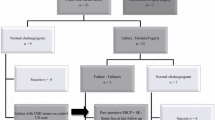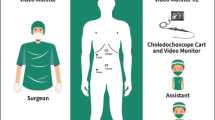Abstract
Background
This study was designed to review the experience of this department with the treatment of post-common bile duct exploration residual stones using choledochoscopy and to analyze the complications of choledochoscopy and explore effective methods of prevention.
Methods
A choledochoscope (PENTAX fibercholedochoscope and electronic choledochoscope PENTAX ECN-1530) was used. A total of 2,882 postoperative percutaneous choledochoscopy (POC) sessions were performed on 986 patients with residual bile duct stones from 1980 to 2008 (408 men, 578 women; ages range, 21–82 years). Forty-five of these had undergone laparoscopic common bile duct exploration (LCBDE); the rest had open bile duct exploration. Seventy-six participants had choledochoscopy examination (for diagnosis only), and in 910 patients it was performed for both diagnosis and therapy (calculi extraction). In 68 cases, plasma shock wave lithotripsy (PSWL) was performed for larger stones before choledochoscopy extraction.
Results
The mean duration of choledochoscopy was 25 min (range, 10 min to 2 h), with a mean frequency of 2.85 times (range, 1–11). No mortalities occurred. The procedure was unsuccessful in 28 cases in which stones were not accessible because they were embedded in distal hepatic ducts or because they were in proximal ducts that were severely stenosed. Complications resulted in 13 cases and included perforated sinus, biliary peritonitis, sinus hypoplasia, destruction of the T-tube system leading to obstruction, basket incarceration, bleeding, and intestinal fistular. Choledochoscopic stone clearance was achieved in 95.5% of the cases.
Conclusions
Choledochoscopy is an important treatment option for hepatolithus. It has a high efficiency for stone extraction and fewer complications. However, it should be noted that some of its complications are potentially life-threatening.








Similar content being viewed by others

References
Shore JM, Lippman HN (1965) A flexible choiedocboscope. Lancet I:1200–1201
Yamakawa T, Komaki F, Shikata J (1978) Experience with routine postoperative choledochoscopy via the T-tube sinus tract. World J Surg 2:379–385
Gocho K, Hiratsuka H (1977) Postoperative choledochofiberscopic removal of intrahepatic stones. Jpn J Surg 7:18–27
Berci G, Shore JM, Morgenstern L, Hamlin JA (1978) Choledochoscopy and operative fluoro-cholangiography in the prevention of retained bile duct stones. World J Surg 2:411–412
Gamal EM, Szabo A, Sziile E, Vors A, Metzger P, Kovacs G, Rozsabegyi J, Olah A, Rozsa L, Kiss J (2001) Percutaneous video choledochoscopic treatment of retained biliary stones via dilated T-tube tract. Surg Endosc 15:473–476
Gartell PC, McGinn EP (1984) Choledochoscopy: are stones missed? A controlled study. Br J Surg 71:767–769
Hall RC, Sakiyalak P, Kim SK, Rogers LS, Webb WR (1973) Failure of operative cholangiography to prevent retained common duct stones. Am J Surg 125:51–56
Ker CG, Huang TJ, Sheen PC (1981) Intrahepatic stones. I. Etiological study. Taiwan I Hsueh Hui Tsa Chih 80:698–711
King ML, String ST (1983) Extent of choledochoscopic utilization in common bile duct exploration. Am J Surg 146:322–324
Takada T, Yasada H, Uchiyama K (1991) Choledochoscopy during biliary surgery for reducing the risk of overlooked stones. Surg Endosc 5:192–195
Hwang MH, Yang JC, Lee SA (1980) Choledochofiberoscopy in the post-operative management of intrahepatic stones. Am J Surg 139:860–864
Ker CG, Sheen PC (1981) Postoperative choledochofiberscopic removal of retained intrahepatic stones. Taiwan I Hsueh Hui Tsa Chih 80:158–169
Mizumoto R, Kire K, Ogur Y, Sato Y (1980) Pathogenesis and treatment of recurrent gallstones. J Surg Treatment (Japan) 42:131–137
Faggioni A, Bondanza G, Filanro M, Pastorino G, Bagarolo C (1985) Tratamento transcutaneo della calcolosi residua/recidiva delle vie biliari. Minerva Chir 40:189–194
Hanyu F, Takata K, Nakamura A, Nakata Y, Furoshima Y, Suzuki S, Imamoto T, Ikaita U (1976) Residual biliary tract calculi. Jpn Clin Surg 31:1549–1559
Neoptolemos JP, Carr-Locke DL, Fraser I, Fossard DP (1984) The management of common bile duct calculi by endoscopic sphincterotomy in patients with gallbladders in situ. Br J Surg 71:69–71
Lambert ME, Martin DF, Tweedle DEb’ (1988) Endoscopic removal of retained stories after biliary surgery. Br J Surg 75:896–898
Chen MF, Chou FF, Wang CS, Jan YI (1982) Experience with and complications of post-operative choledochofiberoscopy for retained biliary stones. Acta Chir Scand 148:503–509
Li Q-L, Wang Q-W, Miao X-Y, Li Y-G (2008) A technique of T-tube replacement. Chin J Gen Surg 17:165–166
Author information
Authors and Affiliations
Corresponding author
Rights and permissions
About this article
Cite this article
Kong, J., Wu, SD., Xian, GZ. et al. Complications Analysis with Postoperative Choledochoscopy for Residual Bile Duct Stones. World J Surg 34, 574–580 (2010). https://doi.org/10.1007/s00268-009-0352-4
Published:
Issue Date:
DOI: https://doi.org/10.1007/s00268-009-0352-4



